Knowledgeispower1
On this page, you find all documents, package deals, and flashcards offered by seller knowledgeispower1.
- 636
- 0
- 26
Community
- Followers
- Following
662 items
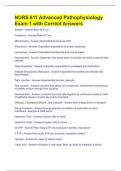
NURS 611 Advanced Pathophysiology Exam 1 with Correct Answers
Sodium - Answer-Main ECF ion. Potassium - Answer-Main ICF ion. Mitochondria - Answer-Organelle that produces ATP. Ribosomes - Answer-Organelles responsible for protein synthesis. Lysosomes - Answer-Organelles that degrade and recycle waste. Peroxisomes - Answer-Organelles that break down chemicals into H202, produces free radicals. Golgi Apparatus - Answer-Organelle responsible for packaging and distribution. Smooth Endoplasmic Reticulum - Answer-Organelle that synthesizes s...
- Package deal
- Exam (elaborations)
- • 3 pages •
Sodium - Answer-Main ECF ion. Potassium - Answer-Main ICF ion. Mitochondria - Answer-Organelle that produces ATP. Ribosomes - Answer-Organelles responsible for protein synthesis. Lysosomes - Answer-Organelles that degrade and recycle waste. Peroxisomes - Answer-Organelles that break down chemicals into H202, produces free radicals. Golgi Apparatus - Answer-Organelle responsible for packaging and distribution. Smooth Endoplasmic Reticulum - Answer-Organelle that synthesizes s...
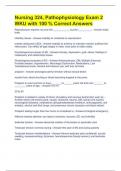
Nursing 324, Pathophysiology Exam 2 WKU with 100 % Correct Answers
Reproductuon requires not only the ____________ but the __________ - Answer-body, brain infertility issues - Answer-inability to contribute to reproduction erectile dysfunction (ED) - Answer-inability to achieve or maintain erection sufficient for intercourse. Can affect all age ranges in male, most seen in older males. Psychological processes of ED - Answer-Anxiety, depression, guilt, stress, feelings of inadequacy and relationship issues Physiological processes of ED - Answer-Arter...
- Package deal
- Exam (elaborations)
- • 7 pages •
Reproductuon requires not only the ____________ but the __________ - Answer-body, brain infertility issues - Answer-inability to contribute to reproduction erectile dysfunction (ED) - Answer-inability to achieve or maintain erection sufficient for intercourse. Can affect all age ranges in male, most seen in older males. Psychological processes of ED - Answer-Anxiety, depression, guilt, stress, feelings of inadequacy and relationship issues Physiological processes of ED - Answer-Arter...
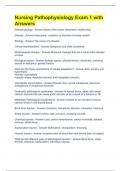
Nursing Pathophysiology Exam 1 with Answers
Pathophysiology - Answer-Study of the body's response to dysfunction Disease - Answer-Interruption, cessation or disorder of a body system Etiology - Answer-The cause of a disease Clinical manifestations - Answer-Symptoms and chief complaints Morphological changes - Answer-Structural changes that are a result of the disease process Etiological factors - Answer-Biologic agents, physical forces, chemicals, nutritional excess or deficiency, genetic factors What are the three mech...
- Package deal
- Exam (elaborations)
- • 15 pages •
Pathophysiology - Answer-Study of the body's response to dysfunction Disease - Answer-Interruption, cessation or disorder of a body system Etiology - Answer-The cause of a disease Clinical manifestations - Answer-Symptoms and chief complaints Morphological changes - Answer-Structural changes that are a result of the disease process Etiological factors - Answer-Biologic agents, physical forces, chemicals, nutritional excess or deficiency, genetic factors What are the three mech...
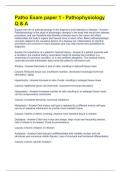
Patho Exam paper 1 - Pathophysiology Q & A
Explain the role of pathophysiology in the diagnosis and treatment of disease - Answer-Pathophysiology is the study of physiologic changes in the body that result from disease processes, and can therefore help identify a disease due to the cause and effect relationships the body's organs and tissues have on each other. Basic pathophysiologic concepts related to the causative factors of a disease (ex: inflammation or infection processes) are common to many diseases and may help narrow the possib...
- Package deal
- Exam (elaborations)
- • 4 pages •
Explain the role of pathophysiology in the diagnosis and treatment of disease - Answer-Pathophysiology is the study of physiologic changes in the body that result from disease processes, and can therefore help identify a disease due to the cause and effect relationships the body's organs and tissues have on each other. Basic pathophysiologic concepts related to the causative factors of a disease (ex: inflammation or infection processes) are common to many diseases and may help narrow the possib...

Pathophysiology Evolve-Exam - Questions with 100% Verified Answers
A nurse is teaching a client about the cause of Prinzmetal angina. Which information from the client indicates teaching was successful? - Answer-Its a spasm of the heart artery A client had an occlusion of a blood vessel from a bolus of circulating matter in the bloodstream. The nurse will use which term in report to describe the client's condition? - Answer-embolus A nurse is teaching an adult class at a wellness clinic about risk factors for atherosclerosis. Which information should the...
- Package deal
- Exam (elaborations)
- • 7 pages •
A nurse is teaching a client about the cause of Prinzmetal angina. Which information from the client indicates teaching was successful? - Answer-Its a spasm of the heart artery A client had an occlusion of a blood vessel from a bolus of circulating matter in the bloodstream. The nurse will use which term in report to describe the client's condition? - Answer-embolus A nurse is teaching an adult class at a wellness clinic about risk factors for atherosclerosis. Which information should the...
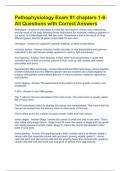
Pathophysiology Exam #1 chapters 1-8- All Questions with Correct Answers
Phenotype - Answer-A phenotype is a trait we can observe. Genes carry instructions, and the result of our body following those instructions (for example, making a pigment in our eyes), is a phenotypic trait, like eye color. Sometimes a trait is the result of many different genes, like the 16 genes responsible for eye color. Genotype - Answer-An organism's genetic makeup, or allele combinations. inclusion bodies - Answer-Inclusion bodies are sites of viral transcription and genome replicat...
- Package deal
- Exam (elaborations)
- • 8 pages •
Phenotype - Answer-A phenotype is a trait we can observe. Genes carry instructions, and the result of our body following those instructions (for example, making a pigment in our eyes), is a phenotypic trait, like eye color. Sometimes a trait is the result of many different genes, like the 16 genes responsible for eye color. Genotype - Answer-An organism's genetic makeup, or allele combinations. inclusion bodies - Answer-Inclusion bodies are sites of viral transcription and genome replicat...
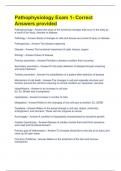
Pathophysiology Exam 1- Correct Answers provided
Pathophysiology - Answer-the study of the functional changes that occur in the body as a result of an injury, disorder or disease Pathology - Answer-Study of changes in cells and tissues as a result of injury or disease Pathogenesis - Answer-The disease beginning Disease - Answer-The functional impairment of cells, tissues, organs Etiology - Answer-Cause of disease Primary prevention - Answer-Prohibits a disease condition from occurring Secondary prevention - Answer-It's the e...
- Package deal
- Exam (elaborations)
- • 3 pages •
Pathophysiology - Answer-the study of the functional changes that occur in the body as a result of an injury, disorder or disease Pathology - Answer-Study of changes in cells and tissues as a result of injury or disease Pathogenesis - Answer-The disease beginning Disease - Answer-The functional impairment of cells, tissues, organs Etiology - Answer-Cause of disease Primary prevention - Answer-Prohibits a disease condition from occurring Secondary prevention - Answer-It's the e...
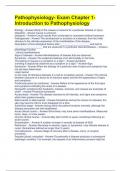
Pathophysiology- Exam Chapter 1- Introduction to Pathophysiology
Etiology - Answer-Study of the causes or reasons for a particular disease or injury. Idiopathic - Answer-Cause is unknown. Iatrogenic - Answer-Cause results from unintended or unwanted medical treatment. Pathogenesis - Answer-The development or evolution of a disease, from the initial stimulus to the ultimate expression of the manifestation of the disease. Description of how etiological factors alter _____________ ________ and lead to _______ _____________ that are observed in a particular d...
- Package deal
- Exam (elaborations)
- • 2 pages •
Etiology - Answer-Study of the causes or reasons for a particular disease or injury. Idiopathic - Answer-Cause is unknown. Iatrogenic - Answer-Cause results from unintended or unwanted medical treatment. Pathogenesis - Answer-The development or evolution of a disease, from the initial stimulus to the ultimate expression of the manifestation of the disease. Description of how etiological factors alter _____________ ________ and lead to _______ _____________ that are observed in a particular d...
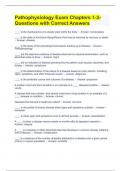
Pathophysiology Exam Chapters 1-3- Questions with Correct Answers
____ is the maintainence of a steady state within the body. - Answer -homeostasis ____ is the state of functional disequilibrium that may be resolved by recovery or death. - Answer -disease ____ is the study of the physiological processes leading up to disease. - Answer -Pathophysiology ____ are the objective evidence of disease observed on physical examination, such as abnormal pulse or fever. - Answer -signs ____ are an indication of disease perceived by the patient, such as pa...
- Package deal
- Exam (elaborations)
- • 4 pages •
____ is the maintainence of a steady state within the body. - Answer -homeostasis ____ is the state of functional disequilibrium that may be resolved by recovery or death. - Answer -disease ____ is the study of the physiological processes leading up to disease. - Answer -Pathophysiology ____ are the objective evidence of disease observed on physical examination, such as abnormal pulse or fever. - Answer -signs ____ are an indication of disease perceived by the patient, such as pa...
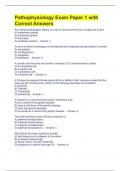
Pathophysiology Exam Paper 1 with Correct Answers
An ordered photographic display of a set of chromosomes from a single cell is a(n): A) metaphase spread. B) autosomal spread. C) karyotype. D) anaphase spread. - Answer -c An error in which homologous chromosomes fail to separate during meiosis is termed: A) aneuploidy. B) nondisjunction. C) polyploidy. D) anaplasia. - Answer -b A somatic cell that does not contain a multiple of 23 chromosomes is called: A) an aneuploid cell. B) a euploid cell. C) a polyploidy cell. D) a hapl...
- Package deal
- Exam (elaborations)
- • 27 pages •
An ordered photographic display of a set of chromosomes from a single cell is a(n): A) metaphase spread. B) autosomal spread. C) karyotype. D) anaphase spread. - Answer -c An error in which homologous chromosomes fail to separate during meiosis is termed: A) aneuploidy. B) nondisjunction. C) polyploidy. D) anaplasia. - Answer -b A somatic cell that does not contain a multiple of 23 chromosomes is called: A) an aneuploid cell. B) a euploid cell. C) a polyploidy cell. D) a hapl...
